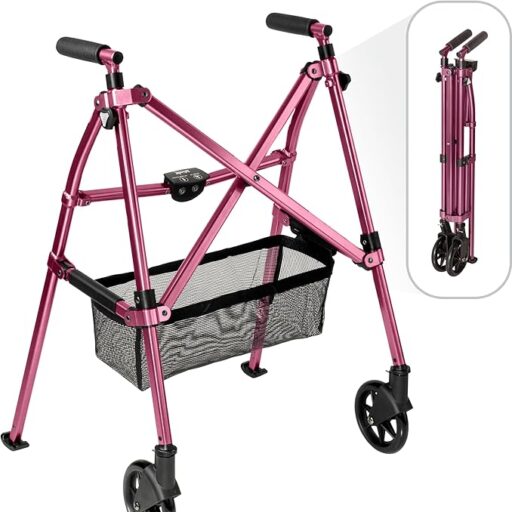Tips for Choosing and Using Walkers: A Comprehensive Guide

Table of Contents
Key Tips for Choosing and Using Walkers:
- Ensure the right fit
- Consider the walker’s weight capacity
- Look for key features for comfort and ease of use
- Test the walker before use
- Use the walker correctly for safety
- Ensure safe surroundings
- Perform regular maintenance
- Replace the walker when necessary
1. Ensure the Right Fit
One of the most important factors in choosing a walker is ensuring it fits the user correctly. The walker should be at the right height, with the top of the handles coming up to the user’s wrist crease when their arms are relaxed by their sides. Proper height adjustment helps maintain good posture and reduces strain on the wrists and shoulders.
Tip: Adjust the walker height so the user’s elbows are slightly bent at about 15 degrees when holding the handles. If you’re unsure about the right height, consult a healthcare professional.A study published in the Journal of Rehabilitation Research and Development found that incorrect walker height can lead to increased strain on the shoulders and wrists, leading to discomfort or further injury in elderly users
2.Consider the Walker’s Weight Capacity
Walkers come with different weight limits, so it’s crucial to choose one that can safely support the user’s weight. Choosing a walker with a weight capacity higher than needed adds stability and ensures safety.
Tip: Always double-check the weight capacity of the walker before making a purchase, especially for bariatric users.
3. Look for Key Features for Comfort and Ease of Use
Walkers come with various features that can enhance comfort and ease of use. Some features to look for include:
- Padded Handles: Look for walkers with cushioned handles, which can provide more comfort, especially for those with arthritis or sensitive hands.
- Brakes: Rollators and walkers with wheels often come with hand brakes. These allow users to control speed and ensure stability when standing or sitting.
- Storage: Many walkers come with baskets or bags for carrying personal items. This is especially helpful when going out for walks or running errands.
Tip: Choose a walker with features that match the user’s lifestyle and needs, such as a built-in seat for resting during long outings.
4. Test the Walker Before Use
Once you’ve selected a walker, it’s important to test it before regular use. Ensure the walker is easy to maneuver, stable, and fits the user comfortably. If possible, try walking on different surfaces to see how the walker performs.
Tip: Make adjustments to the height and features as needed before using the walker regularly. If you have access to a trial model, take advantage of that option.
5. Use the Walker Correctly for Safety
Using a walker correctly is just as important as choosing the right one. Here are some tips for safe and effective walker usage:
- Move the Walker First: Always move the walker a few inches ahead before taking a step. This helps maintain balance and stability.
- Take Small, Steady Steps: Walk at a slow and steady pace to avoid losing balance. Take your time, especially when walking on uneven surfaces.
- Keep Posture Straight: Avoid leaning forward on the walker, as this can strain the back and shoulders. Stand up straight and use the walker for support, not as a crutch.
Tip: Practice using the walker in a safe, controlled environment before taking it outside or into unfamiliar spaces.
6. Ensure Safe Surroundings
The environment in which the walker is used plays a key role in safety. Ensure that the floors are clear of obstacles like rugs, cords, or furniture that could cause tripping or difficulty moving.
Tip: Choose areas with smooth, flat surfaces to reduce the risk of instability. Avoid using the walker on stairs or steep inclines.
7. Perform Regular Maintenance
To keep the walker in optimal condition, regular maintenance is essential. Check the walker periodically for loose screws, damaged parts, or wear on the wheels or brakes. For wheeled walkers, ensure the brakes are functioning properly.
Tip: Inspect the walker before every use and perform minor repairs as needed to ensure everything is in working order.
8. Replace the Walker When Necessary
Over time, walkers can wear out. If the walker becomes wobbly, unstable, or difficult to adjust, it may be time to replace it. Ensuring that the walker is always in good condition is crucial for maintaining the user’s safety.
Tip: If you notice any significant wear or damage, don’t hesitate to replace the walker or its parts, such as the wheels or brakes.
Walker Comparison Guide: Key Features to Look For
| Feature | Standard Walker | Rollator (Wheeled Walker) | Bariatric Walker | Folding Walker |
| Weight Capacity | Lower (usually up to 250 lbs) | Medium to High (up to 350 lbs) | Higher (up to 500 lbs) | Varies (medium to high) |
| Wheels | None or 2 (basic) | 4 wheels (front or all wheels) | 4 wheels (larger, stronger) | 2 or 4 wheels |
| Brakes | No | Yes, hand brakes | Yes, heavy-duty brakes | No or minimal |
| Height Adjustment | Yes | Yes | Yes | Yes |
| Seat | No | Yes | Yes | Optional |
| Storage | No | Yes, with baskets or bags | Yes, with larger storage | Yes, portable storage |
| Portability | Not foldable | Usually foldable, but bulkier | Typically non-foldable | Highly portable |
| Best For | Stable balance, home use | Mobility assistance for active individuals | Heavy-duty use, bariatric needs | Travel and compact use |
Final Thoughts
Choosing the right walker and using it properly can greatly enhance your mobility, independence, and quality of life. Whether you opt for a simple standard walker or a more advanced rollator, it’s important to understand the different types, features, and adjustments to meet your specific needs. Always prioritize safety, and don’t hesitate to consult with a healthcare professional or physical therapist for personalized advice. By following the right tips for choosing and using walkers, you can move confidently and securely, whether you’re at home or on the go.
Frequently Asked Questions
References
The Walker Advisor is a team of experts dedicated to providing honest, research-based reviews of the best walkers and mobility aids for seniors. We gather real user feedback, both positive and negative, to help you make informed decisions. Our goal is to offer unbiased, transparent recommendations that ensure comfort, safety, and independence while meeting your unique needs and budget.
Welcome to The Walker Advisor Newsletter!
The Walker Advisor is committed to helping seniors and their families find the best mobility aids for safe and independent living.
Quick Links
Category
Copyright © 2025 The Walker Advisor All Rights Reserved
